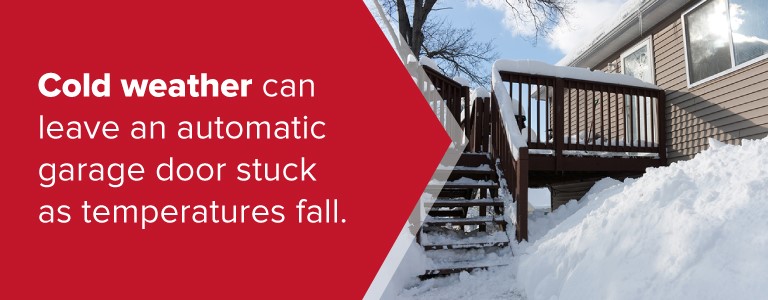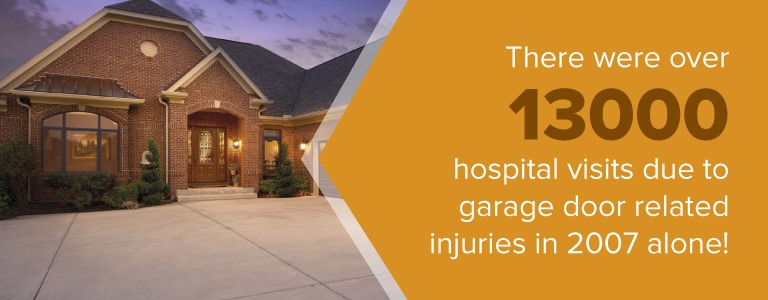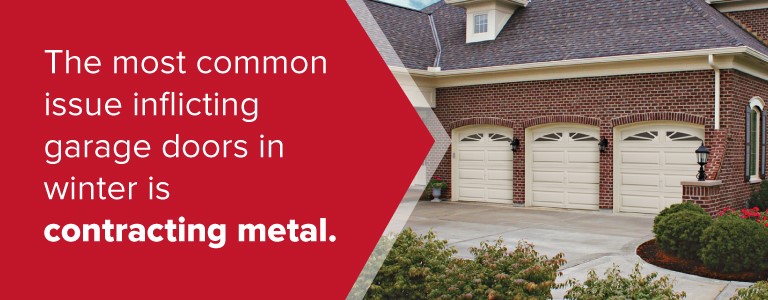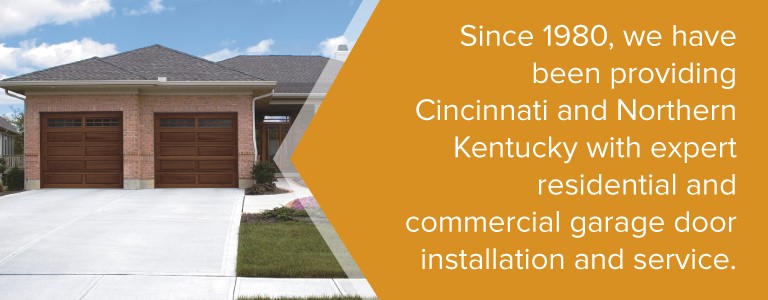Does Cold Temperatures Affect Garage Door Openers? Solutions for Your Winter Garage Door Opening Problems
Garages are the ultimate convenience come winter time. While people who park their car outside are dealing with dead batteries and scraping ice off of their windshields, your car is parked in a cozy garage, oblivious to the freezing conditions outside. When the sidewalks are slick, you don’t have to worry about slipping on the ice while you’re carrying a grocery bag full of eggs. Plus it’s just so much nicer to get into a car that isn’t freezing cold every morning on your way to work!
Unfortunately, there are certain garage door issues attributable to winter. Cold weather can leave an automatic garage door stuck as temperatures fall. Homeowners have woken up on a frosty morning only to discover that their garage door quit working. And in the end, it kind of defeats the purpose when an automatic garage door will not open.

So we’ve put together a guide for all of those who are knee-deep in snow, furious because their garage door system is not opening or won’t close, which will cause garage door problems when it is cold. If you suspect that you’re suffering from a garage door opener not working in cold temperatures, look through our troubleshooting tips in order to figure out if this is a small issue you can take care of yourself or if you’re experiencing a more serious problem that should be left to a professional!
Always Check the Remote First
While a garage door sensor problem may be cold weather related, you would hate to have a service professional come out only to discover that you just needed to replace your batteries in your remote.
No matter if it is a garage door problem in the winter, your first step in your garage door troubleshooting should always be swapping in a fresh set of batteries. Remember, for quality purposes, you should always change the batteries as a set and make sure that you’re using batteries that are all the same brand.
If the batteries are not the problem, it’s time to do some more in-depth investigation.
Try Lifting the Door Manually
One of the best ways to get a real sense of how you door is functioning is to lift it manually. If all you’re doing is pressing the remote and noticing that your door isn’t moving, there are a wide range of possible causes. However, depending on the way your door lifts by hand, you can isolate the problem and take the best approach to getting it fixed.
Start by disconnecting your garage door system from the lift mechanism. This is usually done by pulling on a cord — often with a red handle — that is dangling from the lift. This will allow your door to move independently of your lifting mechanism. It’s also a good thing to know how to do just in case you need to open your garage door when your house doesn’t have power.
Now, try to lift the door by hand and observe how it feels to lift.
If The Door Feels Heavy:
If you’re straining to lift the door because it weighs 500 pounds, that’s because the springs that are supposed to assist you’re either worn or broken.
Garage doors are installed with springs designed to offer counterweight, allowing you to easily lift your door while also greatly reducing the wear and tear put on your motor by making its job easier. Over time, these springs can either wear out or break.
However, keep in mind that you should NEVER try to repair garage springs on your own. They are under incredible pressure, and are liable to snap and cause significant or even lethal injuries. If you suspect that your springs are broken, contact a professional who is trained to do this very dangerous task safely.

Keep in mind, the National Electronic Injury Surveillance System (NEISS) reported over 13,000 hospital visits due to garage door related injuries in 2007 alone!
If The Garage Door Sticks When Opening:
If instead, your door feels about the right weight, but it seems to get stuck at certain moments as you lift it, you’re probably experiencing a lubrication issue.
Remember, a garage door is usually made of metal and pushed along a metal track. That means that lubrication is essential, especially in winter. Keep in mind that lubrication can harden and get gunky as temperatures fall, so make sure that the lubrication on your tracks is rated for the lowest temperature that you’re likely to experience in your part of the world.
You may also experiencing too much lubrication, or lubrication that has become unevenly distributed due to colder temperatures, so make sure to give your tracks a visual inspection as well.
Luckily, reapplying lubrication is a pretty simple job that you can do yourself, as long as your wear proper gloves. While the lubrication may be messy, you also want to be very careful not to accidentally cut yourself on the sharp metal of the tracking.
If The Door Opens Fine by Hand:
If your door opens easily and smoothly by hand, you’ve isolated the problem to the motor. Unfortunately, it’s unlikely that you can fix the motor on your own.
However, just because you’re having a motor issue doesn’t mean that you’re going to have to shell out big bucks in order to get it replaced. There are a number of smaller adjustments that can be made by someone with experience with garage door motors that could get your door up and running.
Standard At-home Preventative Maintenance
Even before you’ve any noticeable issues with your door, there are certain things you can do to ensure that your doors run smoothly. Here are some easy tasks that you should be doing periodically to keep your door in like new condition.
Use A Solvent Regularly:
There is a lot of tough and penetrating dirt and grease that can gunk up your lifting tracks and mechanism. You should regularly apply a spray solvent designed to keep your tracks clear of build up.
Make Sure To Lubricate Pulleys:
While most people take care to lubricate the tracks that guide the door rollers, homeowners often forget to lubricate the pulley system.
Keep in mind, the pulley is often cycled through an enclosed casing that is difficult to lubricate directly. By applying enough lubricant to the pulley, you’re ensuring that the whole lifting mechanism is properly lubricated. Furthermore, a jam in this portion of the lifting mechanism is a time-consuming and potentially labor expensive repair that requires a service professional.
Wipe or Brush Everything Clean:
If you’re diligent about regular cleaning and maintenance, wiping down your door lifting mechanism with a solvent-soaked rag will likely be enough to prevent problem-causing build-up.
However, if you’ve neglected your cleaning duties and you’re already starting to see buildup, generous amounts of solvent and a stiff brush are your best approach. Once you’ve brushed the hinges and rollers thoroughly, approach the area again with a solvent-soaked rag.
Apply a Silicone Based Lubricant Regularly:
Finally, make sure that everything — the screw drive, springs, roller bearings, shuttle, and torsion bar bearings — are well lubricated.
The best way to make sure that your garage door lubricant is performing well all year round is to make sure to use one that is silicone based. Unlike older lubricants, which could become gummy or hard in colder weather conditions, a silicone-based lubricant will be much more stable in winter and still perform in warmer months as well.
Metal Contracts in the Cold
Now to some more substantive issues that can affect cold weather garage door performance. The most common garage door issue in the winter is contracting metal. It’s simple physics that cold temperatures cause metal to contract. As temperatures outside drop, the metal in your door will start to tighten, making movement more difficult.

A well lubricated garage door, especially one that has been properly maintained, will be much more successful in weathering the cold, no pun intended. You can’t stop the metal in your doors from contracting, but you can ensure that the increased friction caused by contracting doors is well mitigated by proper maintenance and door cleanliness.
Unfortunately, if the metal contraction happens quickly — for example, after a rapid freeze — the contraction may actually cause your door track to bend. This is a much more serious problem, and may require repairs further down the road. However, if the bending in your track is minor, your door will still function properly, even if it does make a little more noise.
Ice Between the Door Panels
If your garage door has multiple panels, moisture caught between the garage panels can freeze. This causes the door to lock up and struggle to open.
Luckily, ice between the panels is easy to identify and repair. Start by giving your door a visual inspection. You will likely be able to see the ice.
Once you’ve identified where the ice is, use a hair dryer or some other heat source to melt and dry it. You want to be careful, because you don’t want to damage the metal in your doors by overheating it too quickly. However, some gentle heat will likely fix the problem. Just make sure to dry the moisture so that your door doesn’t freeze again over night.
Damaged Remote Sensor
While it’s rare, sometimes extreme temperatures can damage your remote sensor. This is most common if your sensor cracks due to extreme cold.
Of course, you want to eliminate all other potential remote control issues before assuming that you’re suffering from a cold weather problem. Start by checking the batteries in the remote and ensuring that nothing is obscuring the on-board sensor on the motor.
However, if after checking every other possibility, you still have a communication issue between your remote and your motor, it’s time to call in a professional. They have both the expertise and the specialized equipment to properly diagnose a wide range of motor sensor issues and will be able to help you take the next steps in either repairing your motor or having it replaced.
Damaged or Worn Weather Stripping
While damaged or worn weather stripping isn’t likely to cause problems with the opening mechanism, it’s an issue specific to winter that is worth your attention.
Compare the size of your garage door to your front door. A garage door is much larger and thus is more prone to letting cold air into your home. Weatherstripping is one of your most important defenses against invading cold air.
Unfortunately, as rubber weather stripping ages, it hardens and cracks, which prevents it from doing its job. Hardened weather stripping won’t be nearly as efficient at forming an air-tight seal every time you close the door.
So if you’re worried that your door may be becoming more energy inefficient or if you’ve noticed a sudden spike in your energy costs, look at the weather stripping on your garage door. While you can replace it yourself, remember that effective weather stripping requires a tight seal, so if you’re unsure, you might save money in the long run by going with a professional garage door service
The Value of a Professional
While we understand that everyone wants to save money, keep in mind that you should judge all cold-weather garage maintenance and repair costs in terms of value over the life of the door, not just up-front costs.
Your garage door plays an essential role in your insulation and energy efficiency. A shoddy DIY job may save you money initially, but consider how much you’ll end up losing in subpar insulation.
Similarly, a small repair to your motor, even when done by a professional, is far less expensive than a total garage door overhaul. But if you try to make a repair on your own and end up causing more damage, you won’t actually be saving money on garage door repair when you have to shell out for a completely new motor.
That’s why it’s important to do your research, have confidence in your abilities, and know your limits. In the end, by keeping your garage door beautiful and in peak performance condition, you’re increasing the value of your home.
Garage Door Opener Repair Cincinnati & Beyond

Since 1980, AE Door & Window Co. has provided Cincinnati, Northern Kentucky, and Eastgate with expert residential and commercial garage door installation and service.
In all that time, we have been committed to maintaining a family-owned and operated business that puts honesty and quality first.
Over time, our reputation has provided us with wonderful opportunities, such as supplying the rolling doors for Paul Brown Stadium while also serving as the service provider for Great American Ballpark. We are proud to be known in this city that we love. And as true Cincinnati fans, we are honored to play a small part helping the teams we root for!
So if you find yourself in need of winter weather garage door service in Cincinnati or Northern Kentucky, contact us today! We look forward to hearing from you and doing all that we can to make sure that your garage doors are up and operational all winter long!
